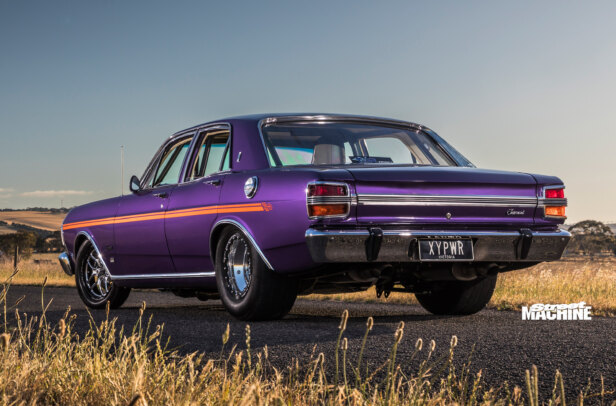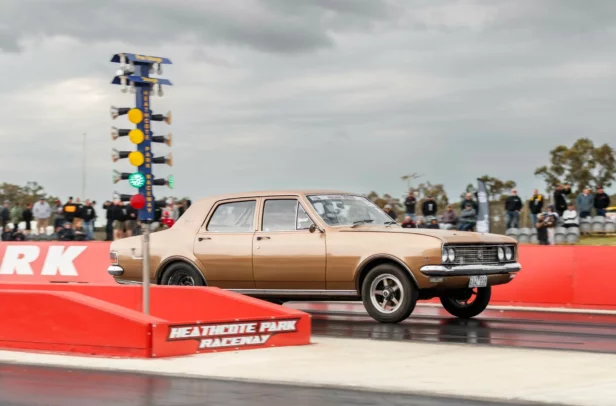GETTING a car down the quarter-mile can be tough, let alone asking it to then back up with thousands of kilometres of highway duty on events like Street Machine Drag Challenge. Many people wanting to build a car for Drag Challenge may fret about their cam specs or if their tune is bang-on, without considering whether their differential is up to the task. Yet the right diff is vital in successfully completing the event.
First published in the October 2021 issue of Street Machine
Matt Dietrich of Geelong Differential Services has the runs on the board when it comes to building third-members, from basic banjos up to sheet-metal units capable of handling several-thousand horsepower. So we asked him to run us through some examples of street/track nine-inch diff builds for Drag Challenge cars.
The diffs we’ll be looking at include a mild unit going into a naturally aspirated, 355ci early Commodore; a garden-variety, 1000hp-rated nine-inch for a big-block Valiant sedan; and a big-banger nine-inch for a naturally aspirated, big-cube Windsor-powered Falcon making 950hp.
CASE STUDY
THE centre case is the heart of the diff, holding the crown wheel and pinion gears.
“Diffs will be set up for different power levels and different uses of the car,” Matt explains. “Someone building a Sunday cruiser compared to a person wanting to drag race will have different requirements, which affects the way we set the hardware up.
“One of the weaknesses we found in OE diffs are the pinion supports, and the fact the pinion bearings are too small. This is why we generally run a Daytona pinion support, as its 12mm-larger diameter gives less pinion flex on hard launches.”
Unless it’s for a restoration project, Matt prefers to work with brand-new aftermarket parts when putting a rear end together. “The problem with factory nine-inch cases is that they’re 50 years old and you don’t know the history,” he says. “You might get a great low-kilometre one, or it could be out of a million-mile-old F-truck that has cracked. Building a new centre means it is all fresh and will last.”
A common upgrade over an OE nine-inch centre case (at left in photo, above) is a nodular-iron unit (middle in photo). Available to suit a variety of axle sizes, these heavy-duty parts are commonly fitted to 1000hp street cars.
“Going from a 35-spline nodular centre up to full-floaters and a Strange Ultra casing means you’re over 1000hp and, generally, running a big tyre,” Matt says. “If you’re building a genuine seven-second car, you need the diff to handle that, but even if you’re aiming for eights you probably should set the diff up in case you end up going quicker.”
The Strange Ultra centre (at right in photo, above) is the largest case you can fit to a nine-inch housing and offers the highest strength, while weighing less than the nodular-iron centre. This aluminium unit can be set up to take huge 40-spline axles if the car is chasing seven-second or quicker timeslips.
“People need to be aware that bigger isn’t always better, especially when it comes to race-spec hardware of this level,” Matt cautions. “Pro Gears are only designed for 1000km, which means they’re not really meant for street use, while the Ultra case needs an adapter to accept a larger bearing so it will cope with the stresses of street use, and they only accept full spools. This customer will race the car with a 4.3-ish gear, then (because he has a floater set-up) he’ll swap a whole new 3.5:1 centre in for the road legs in 10 minutes.”
GRIP IT & RIP IT
NOBODY likes a peg-leg performance car, so fitting a limited-slip centre is key to your car not only getting out of the hole cleanly but driving nicer on the road legs. Pictured here is a full-spool and an Eaton Truetrac, both for BorgWarner (left, above) and nine-inch diffs (right). So which one is best for your car?
“We find a lot of Drag Challenge entrants need the diff to be locked up on the drag strip, but you then have to drive 500km towing a trailer and with a full load on board in your car,” Matt says. “So while a spool is the best thing for straight-line grip, it doesn’t work as well on the road.”
A spool acts as a coupling that locks both axles together, making for fantastic traction. However, this can lead to issues with plough understeer during cornering, as the inside wheel tries to drive at the same road speed as the outside wheel, among other bad behaviour.
“Drag Challenge can go from being 40°C and boiling hot on one day to 18°C and hosing with rain, and a Torana on a big tyre with a spool is a scary thing in the wet,” Matt laughs. “That said, a spool is the only thing that will hold up in a 2000hp car running sevens, because there are simply less moving parts.
“The best thing for most street cars is to fit a Truetrac, as it is a torque-biasing LSD. You get locked traction at full throttle, but it drives like an open-wheeler when it isn’t under load during light or trailing throttle conditions.”
The better on-road manners of a Truetrac are key to surviving Drag Challenge. “You need to find every bit of comfort you can between tracks,” Matt says.
POLES APART
AXLES make a huge difference to the reliability of any car that will see the drag strip. But how do you know whether you need a 28, 31 (left, above), 35 (middle) or 40-spline (right) diff stick?
“New axles are a perfect upgrade for a standard diff,” Matt says. “I tell people not to bother with 28-spline axles; go straight to a 31-spline. For more than 700hp at the crank, you need to go to a 35-spline, as this offers a little bit of future-proofing when you want 800hp.”
Why a larger axle with more splines? “A larger-diameter axle is the key to making diffs live with power, because a larger diameter will always last longer,” says Matt. “You know that saying, ‘there’s no replacement for displacement’? Well, the same is true for axle size.”
The pictured 40-spline Strange axle also features a gunbarrel-drilled centre. This means the centre of the axle has been hollowed out to reduce rotational mass, while retaining all the strength of the 40-spline size.
“Generally, 31-spline axles will be supplied blank, while 35s are generally made in single or dual PCD to suit Chev or Ford, while 40-spline stuff is all made to order,” Matt says.
When it comes time to ditch the flanged axle ends and shoot for a full-floater set-up, Matt reckons there is only one product on the market he trusts. “We only use Race Products floaters [shown at left], as the fit, finish and quality can’t be beaten,” he says.
“The benefits of running a full floater for a Drag Challenge entrant includes the ability to swap between a race and street diff centre quickly. This customer will be able to do that in around 15 minutes without having to remove wheels and brakes, which is important for a big-cube aspirated small-block that will see nitrous down the track with the aim of running 7.50s.”
BUDGET CRUNCH
BEFORE you scour your nearest wrecking yard for tank Fairlanes and F100s for a cheap nine-inch, Matt counsels that any diff going in a Drag Challenge car should be built from brand-new parts.
“With the nine-inch aftermarket being so large, the days of the F100 nine-inch conversion are pretty much over,” he says. “You can buy everything brand new now, so you don’t need to go through the process of rebuilding a tired old F-truck diff to suit your car. Also, a second-hand, 50-year-old XY diff used to be $500, but now it is $3000, which goes a long way towards building a solid new diff from upgraded aftermarket parts instead.”
With so many options in play for setting up third-members, the prices are similarly wide-ranging. Matt doesn’t put a price on any set-up until he has talked through the car with the owner, as this is critical to speccing out the right hardware, which affects costs.
“A nine-inch diff build can cost you anywhere from $3000 to $15,000 depending on how far you plan to go with your car,” he says. “It is difficult to price diffs because each diff needs to suit the engine, transmission, weight, aspiration type and more. Obviously, a diff for a mild 355ci NA VL Commodore will be vastly different to a six-second, full-weight Falcon.”
Matt also cautions against blindly trusting diffs from later-model cars. “People need to realise that even VL Turbo diffs are nearly 40 years old now, so you don’t know what stresses it has seen previous to you running it at Drag Challenge.”




Comments